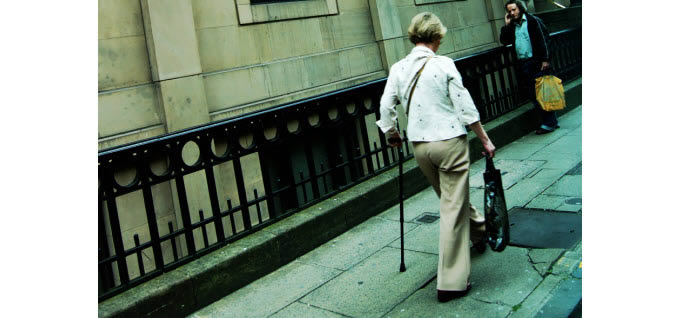I Will Not Use a Walking Cane!
Walking Cane Safety Step 2 – Choosing the Right Walking Cane for Safe Support
Sophia is a 78-year-old senior with weakness on one side of her body due to a recent knee replacement. She has good health otherwise, but just needs a little extra balance support when walking. Her doctor had told her that a cane, which is the lightest walking aid one can use for support, should help her to improve her balance when walking outside her home. She didn’t yet need the assistance of a walker or rollator (a walker with wheels.)
Although urged by her doctor to use a cane to keep her mobile and interacting with friends, she is reluctant to even consider using a cane. She believes that canes are unsafe. She also believes that using a cane will make her look like a “little old lady”. I understand Sophia’s misgivings and am helping her learn how to choose and use a cane safely and with style.
We have properly measured Sophia for a cane, see Walking Cane Safety Step No. 1 – Fitting You for a Walking Cane, so now she may look at the types of canes that can provide her with the safest support.
Although there are many different types of canes all canes have similar components. At the top of the cane is the handle or grip. As you will see when we look at the different types of walking canes, there are many different types and styles of grips. It is important that the grip fits you well and feels comfortable when walking.
Next, is a collar that surrounds the area where the handle is attached to the shaft. Sometimes this collar is made of fancy material or is engraved with a person’s initials.
The shaft is the long part of the cane, and can be composed of wood, metal, carbon fiber polymer and other materials. Some shafts are collapsible for easy portability. For safety purposes, it is important that the cane shaft be the correct length.
At the very bottom of the cane is the tip or ferrule. This is usually covered in rubber to provide better stability. In some canes the tip may be removed and replaced with an “ice-gripper” for better traction in icy conditions. Some canes have four ferrules at the bottom instead of just one. Keeping the cane tip or ferrule in good condition is vital for safe walking.
These components come in a wide variety of types and styles, all designed to suit a person’s safety needs as well as a person’s style desires.
What Type of Cane to Choose for Safe Support
Sophia’s next step is to think carefully about the type of cane that would work best for her. Before considering the many different style features of a walking cane, such as the color of the cane or whether it featured kittens or butterflies on the shaft, Sophia needed to look at four types of canes to determine which type best suited her safety needs:

1. Straight Canes focus on balance support and come with one base point usually in the form of a removable/replaceable rubber tip. Straight canes frequently come with a rounded handle, known as a crook handle or a rounded nose, in wood or light-weight but strong aluminum. Inexpensive straight canes come with a one-piece shaft usually made of wood, or an aluminum shaft that can be adjusted for height. Straight walking sticks can also come in what is considered a more stylish handle: “Derby” handled or “Fritz” handled walking sticks.
2. FOLDING CANES are usually adjustable height derby canes that can be folded in sections for easy storage. Another type of folding cane is one with a shaft of aluminum tubing with a durable stretch rope inside. It will fold down with each section securely sliding into the lower section.
3. Offset Canes come with a “J”-shaped handle and are designed to provide balance support with comfort, especially if you have wrist problems and are unable to hold the cane with a firm grip. This helps a person distribute their body weight over the cane’s shaft for increased comfort. Offset canes offer a greater selection of height adjustments and also have removable/replaceable rubber tips.
4. Quad Canes or broad-based canes focus on balance support with comfort just as an offset cane, but quad canes offer additional stability support. The base of a quad cane has four points meeting the ground. This also allows you to let go of the quad cane and it will stand up alone. Quad canes come with large quad bases or with mini quad bases, both of which offer extra support for the user.
Sophia was not a heavy person nor did she require a cane to bear much of her weight. So she did not require a heavy-duty cane. For people that are over 250 lbs and who need extra support or weight bearing from their walking cane, they should look at bariactic canes. If in doubt, it is a good idea to consult your doctor or physiotherapist for a recommended type or style of cane.
Sophia was amazed by the many different types of canes that are available today. She had no idea they had so many safety features and that they came in so many different shapes. She had a difficult time choosing which type of cane she liked best. She liked the quad cane for safety reasons but she also liked the folding cane for convenience.
When I told Sophia that we had not yet seen the different types of cane handles or grips and that we had not yet considered all the different types of cane tips, she was even more amazed. So with a feeling of being in a candy store we moved on to take a good look at Walking Cane Safety Step No. 3 – Choosing the Safest Walking Cane Grip and Tips




 and get Cash rewards!
and get Cash rewards!